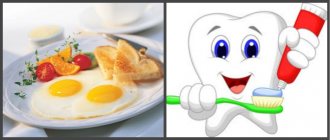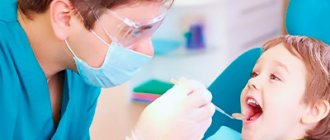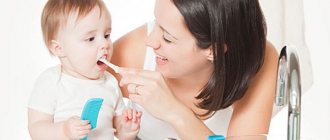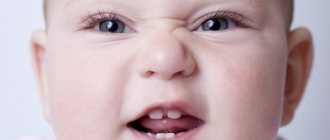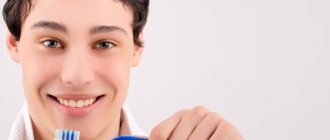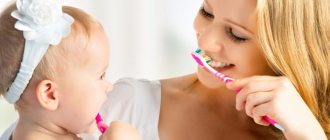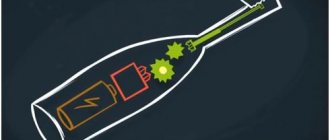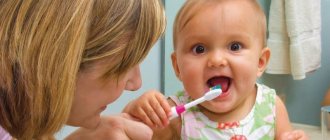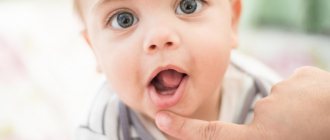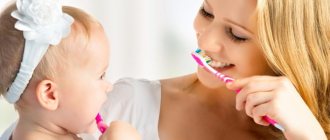July 03, 2018
Averyanova Sveta
The opinion that a baby’s mouth does not need to be cleaned after eating until the first tooth erupts, or even before the primary incisors are replaced with permanent ones, is incorrect. The enamel of children's jaws is thin and susceptible to decay and caries. Those incisors that are still waiting their turn become infected with bacteria. Cleaning your mouth from one year of age or younger can help prevent dental problems in the future.
How many times a day should you brush your teeth?
When it comes to how many times a day you should brush your teeth, dentists are unanimous. Brushing your mouth twice a day is ideal for optimal dental health. For best results, teeth should be brushed before the first meal and after the last meal. Some people believe that cleaning after every meal is more important, and you can't blame them for being wrong.
In fact, brushing after every meal is recommended for people who are prone to tooth decay or whose mouth is in poor condition. In addition, people who wear braces are also required to brush their teeth after every meal due to the fact that the food they eat tends to get stuck between the braces and the teeth. Brushing your teeth twice a day is a habit that should be instilled from childhood. when a child begins to explore the world.
How to use dental floss?
Dental floss is an indispensable attribute of good oral hygiene. Unfortunately, even adults rarely know how to use it correctly. The main trick is not to try to forcefully insert it into the interdental space (this usually ends in a rather painful injury to the gums). To avoid injury, the thread must be inserted with a “sawing” motion, pressing it against one of the teeth. Having thoroughly cleaned its inner wall, the thread is reinserted into the same gap, pressing it against another tooth.
How long should you brush your teeth?
It is enough to brush baby teeth for 2 – 3 minutes. This is the norm for both adults and children. If your child can’t stand it for that long, try to turn brushing your teeth into a game, as described above, since simple coaxing is unlikely to help. In order for the child to have only pleasant impressions of the procedure, try doing it, say, to children's songs. Also try to explain how many times a day you should brush your teeth. Try to cultivate in your child the desire to take care of their teeth; in the future, this will undoubtedly have a beneficial effect not only on their beauty, but also on their health.
How to teach a child to brush their teeth
To begin, prepare your child for daily brushing by wiping his teeth and gums with a soft, damp cloth. Remember to wash your hands thoroughly. Use your finger to gently massage your baby's gums. As soon as your child reaches the age of two, buy him a toothbrush for children and start teaching him how to brush properly. In the beginning, the child will not be able to hold the brush properly, and therefore it is important to observe this process and correct it when necessary. You may need to continue helping your child brush his teeth until he is 6 or 7 years old.
It is at this age that children develop the ability to consciously do something. Even if your child insists that he can clean his mouth on his own, it is still best for you to supervise his actions. Many children do not like to do this, and may try to speed up the process by missing many important areas, either on the chewing surface or between the teeth.
Use only a soft toothbrush to avoid damaging your baby's delicate gums. Children who may swallow some of the toothpaste should buy fluoride-free toothpaste. Children get enough fluoride from their drinking water, and swallowing fluoride from toothpaste may actually do more harm than good. Also, fluoride, in excess amounts, can cause teeth to turn black. teeth brushing calendar will help you get used to brushing your teeth.
Why do you need a teeth cleaning calendar? This is a great way to remind your child to brush their teeth in the morning and evening.
Teeth brushing calendar for two children
Let your teeth always be healthy!
We will be happy to post your articles and materials with attribution. Send information by email
What are the small brushes for?
There are small toothbrushes on sale with one thin tuft of bristles, the purpose of which is unclear to many parents. In fact, they are very convenient because they allow you to precisely clean the cervical areas of all teeth. When parents start using such brushes, problems associated with the difficulty of cleaning hard-to-reach areas immediately go away.
By remembering well and carefully following all the points of this small checklist, you can be sure that your baby’s teeth will be in order. If you do not understand how any of the described movements are done, be sure to watch the video, in which all this is not only explained in detail, but also clearly shown.
How many times a day should you brush your teeth?
Every adult knows: it is necessary to brush your teeth in the morning, before enjoying breakfast, and in the evening, before going to bed. Twice a day is quite enough - this is the opinion of most dentists.
In some cases, doctors recommend that patients use a toothbrush more often. This is required if:
- there is a tendency to carious lesions;
- gums often become inflamed;
- man wears braces.
In such situations, dentists advise brushing your teeth 3-4 times or after each meal. It is especially important to do this if you have a braces system: pieces of food tend to get under the structural elements, as a result of which the enamel deteriorates and caries develops.
The same rules apply to children. General recommendations: a child should brush their teeth twice a day, but if they have illnesses or have braces installed, then more often.
It is enough for adults to receive information about what measures to take to protect their teeth. For children, you will have to come up with games that transform the cleaning process from a tedious task into an exciting activity.
To ensure that visits to the dentist do not cause unpleasant emotions, but are a regular medical examination without the need to drill out cavities and remove hard plaque, develop a brushing schedule for your child and begin to follow it together.
Practicing the technique
As in adults, when cleaning the outer and inner surfaces of the teeth, the brush is placed at an angle of 45 degrees to the tooth and sweeping movements are made from the gums to the edge of the tooth. To clean the chewing surface, the brush is positioned horizontally and moved in a circular motion. If you are afraid of overdoing it, watch the video on how to brush your teeth properly. They will explain and clearly demonstrate to you how it should be. The whole family can watch this video on how to brush your child’s teeth. In addition, your baby will also be interested in watching a cartoon about how other children brush their teeth.
How long should you brush your teeth?
The frequency of brushing your teeth usually does not raise questions or doubts. How many minutes does it take for it to be successful?
For the youngest, the first procedures should take a few seconds. The mother puts a special plastic finger guard with a tiny brush on one side on her finger and gently massages the baby's teeth.
Finger guard for babies
When should I start doing this procedure? If your baby is 7 months old and his first teeth have erupted, it’s time to start teaching him to brush.
Later, by about two years, you need to accustom your child to the fact that the duration of brushing will be 2-3 minutes.
During this time, you need to have time to clean the chewing surfaces, pay attention to the inside of the teeth and the interdental spaces. Teach your child to gently massage the gums - this is necessary to improve blood circulation in their tissues.
How to teach a child to brush their teeth
The best option for forming a sustainable habit in a child of brushing his teeth twice a day is play. How to make your task easier and speed up the process? Try the following methods:
- tell your child an interesting fairy tale in which a toothbrush appears, as well as “bad” and “good” microbes and bacteria;
- brush your teeth with him - let him watch your movements and repeat them; help the child in the process - after all, he does not yet know how to handle a brush;
- buy for your son or daughter “delicious” toothpaste and a brush that has stickers or three-dimensional images of his favorite “cartoon” characters;
- download a special calendar, print it and hang it in a visible place, and so that the baby can easily reach it - we’ll tell you why this is needed below.
Toothpastes that are interesting to children
The main thing is that the child must learn that brushing his teeth twice a day is a necessary part of the regime, just like washing his face after getting up and going for a walk after breakfast. Your task is to make your baby want to brush his teeth - this activity should be interesting for him.
Poems about brushing teeth for children
Interesting, funny poems and rhymes about brushing your teeth can help mothers. They will tell the child about the rules of hygiene, become motivators for mastering the skill of self-care, while simultaneously expanding the toddler’s vocabulary. Use the following verses for “dental” games, memorize the quatrains together.
Tell story poems before bedtime, during daytime games. Repeat them several times so that the meaning of sad stories about unbrushed teeth is fully understood by the baby.
Recommendations from Dr. Zubastik
Teaching a child to brush their teeth twice a day is an important task that only parents can solve. Neither kindergarten nor school can help here. Therefore, watch your child: what is more important for him - to see your personal example? Participate in the process of brushing your teeth together? Show creativity - color pictures on the calendar? Use any method that is interesting and enjoyable for the child. Brushing his teeth should become a mandatory daily ritual for him, associated with pleasant emotions. And then caries or stomatitis will not be scary for your baby!
A short video: teaching kids to brush their teeth:
Oral care products
Before the appearance of the first incisors and molars, oral hygiene in newborns includes only wiping the gums and tongue. This way, parents can quickly remove harmful plaque and cleanse the child’s mouth of bacteria.
When the first tooth appears, it is recommended to clean it with a soft gauze swab or a special damp cloth. Even the softest brush will be unpleasant for a baby in such a delicate state.
ASEPTA BABY finger wipes from 0 to 3 years will help relieve unpleasant symptoms during teething. These amazingly pleasant massage tools will ensure gentle oral hygiene for the baby and massage the gums during teething.
- The corrugated surface of the napkins will give a light massage to the gums.
- Impregnation with plant extracts will prevent inflammation and help balance the acid-base balance of the oral cavity.
Wipes will help your baby form the habit of daily oral hygiene, providing daily pleasant procedures. ASEPTA BABY wipes will be especially convenient when traveling, because with them you can brush your teeth even in road conditions. Each napkin is individually packaged in a sealed bag, so their one-time use is 100% hygienic.
A bandage or gauze swab lightly moistened with boiled water is also suitable for wiping the first teeth of babies. Under no circumstances should you use cotton wool for daily oral hygiene in infants - this material is not suitable for their texture. Rough cotton wool will leave fibers behind, which can cause even more inflammation of the gums.
Brushing teeth after six months
In infants older than six months, the ejection reflex disappears. From this age, parents can use other means to clean their baby’s delicate teeth.
Finger toothbrush
A silicone brush will be a salvation for parents of infants. At an early age, the baby is not yet able to hold a toothbrush on his own and make the necessary movements with it, so you can brush your teeth with the help of a special fingertip.
Classic brush
A children's toothbrush is, first of all, a tool with very soft bristles. It is better that the children's brush has short and soft bristles, as well as a short and comfortable handle with which you can brush children's teeth. The first brush can be used from 1 year.
Toothpaste
Children should never brush their teeth with adult toothpaste. This hygiene product should also be selected according to the baby’s age.
For infants who are not yet receiving complementary foods, a gel-like paste with a neutral or milky taste is suitable. It is important that the product does not contain various abrasive substances, and that its taste evokes exclusively positive emotions in the baby.
An excellent means for cleaning teeth will be the children's gel paste from 0 to 3 years old ASEPTA BABY, designed for gentle care of the gums and baby teeth of babies. Children like its pleasant “tutti-frutti” taste, which makes brushing their teeth a joyful procedure and helps form a healthy habit of daily oral hygiene.
- The complex composition allows you to simultaneously care for your gums and teeth.
- The gel base provides gentle cleansing of teeth and gums.
- The paste is safe to swallow, as it does not contain components that can harm the baby's health.
ASEPTA BABY paste does not contain fluoride, therefore it does not require consultation with a doctor before use.
